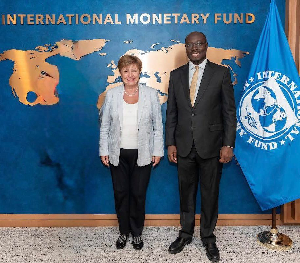.. also Pro-Poor
(A WB research desk report compiled by Francis Ameyibor of Ghana News Agency)Accra, Jan 21, GNA - Whether or not one has access to credit is a litmus test for wealth or poverty. If you are rich, you have it, and can use it to get richer. If you are poor, you don't have access to it, and you remain poor.
The conventional wisdom suggests that building up the financial sector has little effect on this gap. But new World Bank (WB) research reveals that a high level of financial Development that is, where private credit (extended by financial institutions to households and private firms) accounts for a high percentage of GDP may well be a result of wealth, but it is also a powerful driver of poverty reduction.
According to the research, when private credit is a bigger share of GDP, poor people get more out of growth. It is to be expected that a strong financial sector, with sound banks, lively stock and bond markets, established insurance companies, and multiple financial intermediaries, stimulate economic growth.
The WB research revealed that in countries with well-developed financial sectors where private credit accounts for a bigger share of GDP, the poor get a bigger income boost from growth. While, poor people living in countries with the same growth rate, but in which private credit accounts for a smaller share of GDP, stay poorer. Micro-finance schemes can help bridge part of the gap by providing loans to the poor, enabling them to launch small enterprises, which would otherwise never be created. Micro-finance is important to the extremely poor, who have no access to other sources of credit. But it accounts, at best, for only a small share of all private credit, that is, the total amount of credit channelled from savers through banks and other financial intermediaries, to private firms.
Recent research by a team of financial experts headed by Mr Asli Demirguc-Kunt, Research Manager of the WB's Development Economics Research Finance Team indicate that raising the proportion of private credit available triggers more rapid increases in the incomes of the poor, relatively speaking, as it stimulates growth for the whole economy.
In other words, financial development increases national income and reduces income inequality at the same time. It promotes what may be called pro-poor growth.
On financial sector development and achieving the Millennium Development Goals, Mr Demirgue-Kunt said the findings suggest that financial sector development is an essential determinant of a country's prospects for achieving the eight Millennium Development Goals.
Mr Demirguc-Kunt said the foremost of these is to reduce by half the proportion of people living on less than $1 a day by 2015.
This hitherto unnoticed pro-poor dimension of finance is due to two factors.
First, as financial sectors deepen they also increase their reach, providing financial services directly to poorer clients. More evaluation studies are needed to measure the scale of their overall impact, but experience suggests that micro-finance has made a big difference for those who have access to it.
The second, arguably more important factor according to the WB findings is that even when financial development does not touch the poor directly, it does improve overall economic performance in ways that deliver isproportionately increased incomes to the poor. "More abundant private credit creates a rising tide that lifts all boats, but gives a bigger lift to the poorest ones," concludes Mr Demirguc-Kunt.
This finding shows that - controlling, for other country characteristics greater financial development is associated with poverty alleviation. 'Growth in Headcount' is the average annual growth rate of the percentage of the population living on $1 a day or less over the period 1980-1999.
'Private credit' is the claims on private sector by deposit money banks and other financial institutions as a share of GDP. According to Mr Demirguc-Kunt, evidence from a comparative analysis of average annual growth rates in poverty, private credit and GDP over 20 years show that countries with higher levels of private credit reduced poverty more quickly. For example, in Chile, where private credit accounts for 54 percent of GDP, the percentage of people living on less than $1 a day decreased by 14 percent a year between 1987 and 2000.
But in neighbouring Peru, where private credit amounts to just 13 percent of GDP, the proportion of extremely poor rose by 19 percent from 1985 to 2000.
The new estimates, taken at face value, imply that, if Peru's financial sector had been as developed, or its private credit market as well-stocked as Chile's, the proportion of the population living on less than $1 a day could be just two percent, instead of 15 percent a difference of 3.4 million people.














